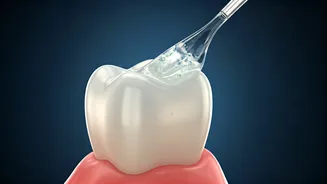The Enamel Challenge
Tooth enamel is the hardest substance in the human body, but it's also incredibly vulnerable. Once damaged, it doesn't regenerate, making us reliant on
artificial fixes like fillings and crowns. This protective outer layer shields teeth from the everyday onslaught of acids, bacteria, and wear and tear. When enamel erodes, the softer dentin underneath is exposed, leading to sensitivity and an increased risk of cavities. Current dental procedures focus on patching up damage, but these solutions are temporary fixes. The new research offers a truly restorative approach by attempting to rebuild lost mineral density, aiming to change the very foundation of oral health treatment. This approach addresses decay at its earliest stages, preventing the need for more invasive procedures.
How It Works
The secret behind the new gel lies in biomimicry – copying nature's methods. Scientists created a glycerol-stabilised calcium phosphate cluster that replicates enamel's crystalline structure. During tooth development, cells called ameloblasts guide calcium and phosphate ions to form enamel. After teeth erupt, these cells are lost, making natural regrowth impossible. Researchers used the cluster to develop a material that mimics the crystalline structure of enamel. When the gel is applied to damaged enamel, the clusters bind and swiftly form a protective layer. The gel integrates seamlessly with the tooth surface, acting as a self-healing treatment for minor cavities and erosion, which no existing toothpaste or mouthwash can achieve. In laboratory tests, the gel has proven its ability to restore early-stage enamel erosion within hours, displaying strength and acid resistance like that of healthy enamel.
Benefits Unveiled
If clinical trials confirm its safety and effectiveness, this groundbreaking gel could drastically change how dentists approach oral health. One of the main advantages is early cavity prevention. By halting decay before it advances, the need for drilling and fillings could be significantly reduced. This also means decreased tooth sensitivity. The new enamel layer closely mirrors natural enamel, improving durability, which, in turn, may naturally alleviate discomfort caused by temperature changes or acids. A potential benefit of this technology is accessible preventive care, the gel could be administered by dentists or potentially used in at-home treatments. This makes enamel protection easier for everyone. The potential is immense, promising a future of dentistry focused on regeneration rather than mere repair.





